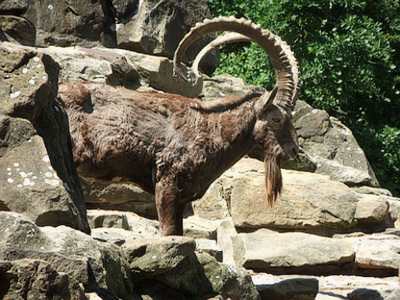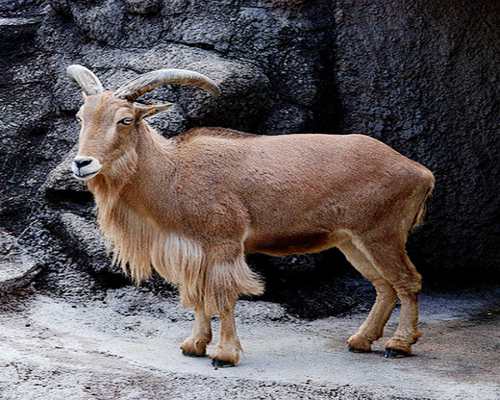Caprines, the colossal members of the goat family, stand out as the world’s largest goats. This diverse group encompasses a variety of large-bodied species that captivate with their imposing stature and distinctive characteristics. Among these formidable caprines are the Markhor, the Ibex, and the Tahr, each contributing to the reputation of these magnificent creatures as the true titans of the goat world.
Marked by their majestic spiraled horns and a robust physique, the Markhor takes center stage as one of the most prominent caprines. Flourishing in the mountainous regions of Central Asia, these goats navigate steep terrains with unparalleled agility, showcasing their prowess as both climbers and survivors in challenging environments.
Venturing into the world of Ibex, another noteworthy caprine, reveals a species adapted to rocky landscapes with astonishing ease. The Ibex’s large, backward-curving horns and impressive builds serve as testaments to their resilience in harsh mountainous habitats. From the European Alps to the Himalayas, Ibexes command attention as they navigate precipitous cliffs with unmatched dexterity.
Adding to the grandeur of caprines is the Tahr, a species known for its shaggy coat and distinctive appearance. Thriving in mountainous regions from the Southern Alps of New Zealand to the rugged terrains of the Himalayas, Tahrs exemplify adaptability and strength. With their distinctive, curved horns and sturdy frames, Tahrs carve out a unique space among the world’s largest goats.
While caprines may share a family bond with their smaller goat relatives, their size, strength, and distinct features set them apart as the unrivaled giants of the goat kingdom. The world’s largest goats, the caprines, continue to awe and inspire with their majestic presence in diverse habitats across the globe.
Caprines: The World’s Largest goat-antelope

In the realm of caprines, the world’s largest goats emerge as the exceptional outliers, diverging from their more typical, goat-like or sheep-like counterparts. Two remaining species within this remarkable group challenge the conventional size norms, standing out as larger, more muscular beings. Initial assumptions regarding their close kinship have been dispelled by modern genetic evidence, revealing them as distinct caprines with parallel evolutionary paths toward robustness and stature.
The first protagonist in this tale is the takin (Budorcas taxicolor), a creature of undeniable distinctiveness. The takin’s stature alone distinguishes it from its caprine counterparts, with fully grown males towering over four feet at the shoulder and weighing more than 300 kg (660 lbs). While debates linger about their closer association with goats or sheep, prevailing evidence leans towards goats, suggesting a common ancestry during the evolutionary juncture when goat-sheep distinctions were less clear.
Takins flaunt a robust build, short backward-curving horns, and a shaggy coat adorned with a goat-like beard, presenting a unique aesthetic. Found in the eastern Himalayas and mountainous regions of central China, takins, although not as agile as cliff-climbing goats, navigate high elevations and steep slopes with resilience. Their diverse coat colors, ranging from rich golden-yellow to dark brown, further contribute to their captivating presence.
Primarily dwelling in forests, takins inhabit broadleaf and coniferous woodlands on mountainous slopes, thriving at elevations between 1200 and 3500 meters (4000 to 11,500 feet). Demonstrating determination, they migrate to treeless meadows during the summer, even braving earthquakes to adhere to their seasonal patterns. With a preference for heavy bamboo undergrowth, takins, adept browsers, showcase their strength by ripping down entire branches.
Active during the early morning and late afternoon, takins form herds comprising females, sexually immature males, and dominant older males responsible for breeding. During the breeding season, herds disband into smaller groups, fostering a temporary rut conducive to mating. Intriguingly, pregnant takins remain within the herd, showcasing collective defense mechanisms to protect the young calves.
While takins captivate with their size and strength, the title of the largest caprine goes to the muskox (Ovibos moschatus). Contrary to popular perception, muskoxen are genuine caprines, more closely related to goats than cattle, despite their stocky and bovine appearance. Thriving in the harsh, frigid climates of Canada and coastal Greenland, muskoxen have adapted to lowland areas, dispelling the need for the cliff-climbing prowess of their caprine relatives.
Endowed with thick, shaggy coats and a layer of fat, muskoxen withstand temperatures as low as -40°C (-40°F). While not towering giants like takins, fully grown males stand at a shoulder height of no more than five feet but can weigh up to 410 kg (900 lbs). As avid grazers, they subsist primarily on grasses and sedges, leveraging their unique digestive systems to extract nutrients from low-quality forage.
Inhabiting Canada and coastal Greenland, muskoxen form herds during summer and winter, employing a unique defensive strategy of circling together when threatened. The strength of their collective defense mechanism lies in the unity of the herd, with powerful males facing outward to protect the vulnerable calves within.
Mating in late summer to early autumn, muskoxen display their distinctive musk, secreted to attract females during nocturnal mating rituals. Despite challenging environmental conditions, muskoxen give birth to their calves in freezing temperatures, highlighting their resilience in the face of adversity.
While takins and muskoxen stand as the world’s largest goats, their evolutionary paths and adaptive strategies showcase the remarkable diversity within the caprine family. As these majestic giants navigate mountainous terrains and Arctic landscapes, they unravel the intricate tapestry of survival and adaptation woven by caprines across the globe.

